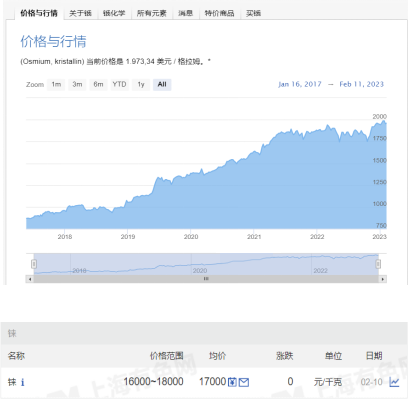Can Osmium (OS) Replace Rhenium (Re) as The Most Important Strengthening Element in Nickel-Base Single Crystal Superalloys?
- Categories:Application Technology
- Author:
- Origin:
- Time of issue:2023-03-20
- Views:0
(Summary description)Recently, a team of Central South University including Professor Huang Zaiwang and Professor Zhang Lijun published a paper in ACTAMATERIALIA, reporting the latest research trends: the creep resistance and phase stability of nickel-base single crystal superalloy are improved by replacing Re with OS. So, how likely is it that osmium (OS) will replace rhenium (Re) as the most important strengthening element in ni-base single crystal superalloys in practical production and application? Let's read through the core meaning of this paper.
Can Osmium (OS) Replace Rhenium (Re) as The Most Important Strengthening Element in Nickel-Base Single Crystal Superalloys?
(Summary description)Recently, a team of Central South University including Professor Huang Zaiwang and Professor Zhang Lijun published a paper in ACTAMATERIALIA, reporting the latest research trends: the creep resistance and phase stability of nickel-base single crystal superalloy are improved by replacing Re with OS. So, how likely is it that osmium (OS) will replace rhenium (Re) as the most important strengthening element in ni-base single crystal superalloys in practical production and application? Let's read through the core meaning of this paper.
- Categories:Application Technology
- Author:
- Origin:
- Time of issue:2023-03-20
- Views:0
Recently, a team of Central South University including Professor Huang Zaiwang and Professor Zhang Lijun published a paper in ACTAMATERIALIA, reporting the latest research trends: the creep resistance and phase stability of nickel-base single crystal superalloy are improved by replacing Re with OS. So, how likely is it that osmium (OS) will replace rhenium (Re) as the most important strengthening element in ni-base single crystal superalloys in practical production and application? Let's read through the core meaning of this paper.
Rhenium (Re) is a paramount strengthening element in nickel-based single crystal superalloys because of its low diffusion coefficient, high melting point and high partition coefficient between γ and γ' phases. However, its detrimental influence on phase stability has remained a long-standing problem to be solved. In this paper, we report a new design strategy to improve creep resistance and phase stability of nickel-based single crystal superalloys by replacing Re by osmium (Os), which contradicts the common belief. The experimental observations clearly show that the creep rate of newly designed CSU-Os-2 alloy is lower than that of commercial CMSX-4 alloy at 980 °C/200 MPa/100 h. Moreover, the CSU-Os-2 alloy also owns the better phase stability after exposure at 1100 °C for 1000 h, compared with CMSX-4 alloy.
Ni-base single crystal superalloys have typical microstructures with a high proportion of coherent precipitated γ' (ordered FCC-L12 structure) cubes separated by a thin channel (disordered FCC-A1 structure) of γ matrix, with excellent mechanical properties and high creep and fatigue resistance at high temperature, so it is widely used as a basic material for high pressure turbine blades. In order to meet the requirements of increasing turbine inlet temperature, Ni-based single crystal superalloy needs higher creep resistance and microstructure stability. In the past few decades, more and more refractory alloy elements, such as Mo, W, Ta, Re, have been introduced into Ni-based single crystal superalloys to improve their creep resistance and phase stability. For example, the total amount of W + Mo + Ta + Re increased from 16.4 wt. % to 20.1 wt. % . Re (rhenium) is the most effective modifier to enhance creep deformation because of its very low diffusion coefficient, high melting point and strong distribution behavior of γ phase. Despite its attractive benefits, the addition of higher amounts of Re in the new generation Ni-based single crystal superalloy may induce the precipitation of brittle topological dense arrangement (TCP-RRB- phase, which accelerates the alloy's failure.
Therefore, the whole world is trying to solve the problem of TCP precipitation. One feasible measure is to introduce Ru (ruthenium) , because its addition can reverse the distribution behavior, increase the solubility of RE and W in γ-matrix phase, and decrease the TCP/γ interface energy and γ/γ' mismatch strain energy. Unfortunately, Ru addition may also lead to topological inversion, especially at high temperature, which in turn will affect the creep fracture life of ni-base single crystal superalloy. Therefore, it is necessary to search for other possible elements to replace Re or Re/Ru, aiming at exploring new ni-base single crystal superalloy. An effective strategy is to search for elements with the same or lower cross-diffusion coefficient as Re in γ-matrix of Ni-based single crystal superalloy. By combining the HITDIC software with the diffusion coupling/multiplex technique, the temperature-and composition-dependent cross-diffusion coefficients in a series of binary, ternary and multicomponent γni-based alloys can be determined effectively. A comprehensive comparison of the interdiffusion coefficients in γni-x and Ni-Al-X (x = Co, CR, Ir, MO, NB, Os, PT, RE, Rh, Ru, Ta, Ti and w) alloys 1423-1573K shows that the co-diffusivity of OS is generally equal to that of Re, and even lower at higher temperatures (i.e. ≥1300 ° C) . As far as the cross diffusion coefficient in γ matrix is concerned, OS may be a potential replacement element for Re in Ni base single crystal superalloy.
The possibility of replacing rhenium with osmium in ni-base single crystal alloy was theoretically analyzed in detail from the aspects of solid solution strengthening, creep resistance and microstructure stability. Under the circumstances of positive confirmation, by replacing Re with OS in a commercial CMSX-4 alloy, Zhang Lijun's team in the State Key Laboratory of Central South University has designed a new Re-free nickel-based superalloy called CSU-OS-2, then the single crystal rod was successfully prepared. With proper solution and aging heat treatment, the segregation is almost alleviated and typical γ/γ' microstructures are produced as in commercial alloys. At 1100 ° C/1000h exposure, the coalescence of γ' precipitates in CSU-Os-2 alloy was slower than that in CMSX-4 alloy, and no TCP phase was observed. After creep deformation at 980 ° C/200 MPA/100 h , the creep rate of CSU-Os-2 alloy is lower than that of CMSX-4 alloy. All attractive properties/properties can be explained by the higher partition coefficient between γ and γ' phases and the likely lower diffusion coefficient of OS than Re in the γ phase. The successful development of a new type of ni-base single crystal superalloy without re and osmium has enhanced creep resistance and microstructure stability, which will undoubtedly open up a new direction for the next generation of ni-base single crystal superalloy.
This sentence reveals the core significance of the paper. After reading the thesis, we return to the question raised at the beginning of this paper: How likely is it that osmium (OS) will replace rhenium (Re) as the most important strengthening element in ni-base single crystal superalloy in practical production and application? To answer this question, we analyze and expound the author's viewpoint from the following three basic aspects: the recoverable amount of Re and OS on the Earth, the cost of extraction and smelting process, the current market price and the production and supply capacity.
1.Resource Reserves
Osmium (OS) has a density of 22.59 g/cm3, making it the densest metal element on Earth. Osmium is a platinum group metal and the global annual output of osmium is only about 500 kg, less than 1/5000 of gold. According to the USGS 2022 Mineral Commodity Summaries 2022 - Platinum, platinum accounts for about 50 percent of the 70,000 tons of proven platinum-group reserves globally, palladium for about 35 percent, ruthenium, iridium and rhodium for the rest, and osmium is the rarest of the platinum-group elements, in the platinum group content of less than 1% , that is, the global reserves estimated at about 700 ~ 1000 tons.
Rhenium (Re) , with a density of 21.03 g/cm3, is also a rare earth element. The world's proven reserves of rhenium are about 2,500 tonnes, with resource reserves of no less than 10,000 tonnes, less than one-tenth of gold, and annual global production of about 100 tonnes. About 50% of rhenium production is currently used in the production of nickel-based superalloys.
2. The cost of extraction and smelting process
Rhenium is usually associated with copper and molybdenum. In the process of smelting copper and molybdenum, most of rhenium is recovered as a valuable by-product, so the cost of extracting and smelting is relatively low. However, osmium is usually associated with iridium, and the very low content of osmium in platinum group ores, combined with the high toxicity of osmium oxide osmium tetroxide OSO4, leads to high extraction and smelting costs.
3. The current market price and the production and supply capacity
The international price of osmium in US dollars is close to US $20/g, about RMB 150/g and 150,000/kg, while the production of rhenium is 100 tons, and the market price is RMB 170/g, 17,000/kg. In terms of production, rhenium is 200 times that of osmium; in terms of price, rhenium is only a tenth that of osmium.

Price comparison of osmium and rhenium
To sum up, in the practical production and application of ni-base single crystal superalloys, it seems that it is far from simple to make osmium (OS) completely replace rhenium (Re) as the key strengthening element, however, the introduction of osmium into traditional ni-base superalloy is a new scientific research direction, which is worthy of reference for the industry.
Rheniumet Ltd. is in line with the world's major application terminals in the development, production and manufacturing technology of rhenium and its alloys, continuing to serve users in the aerospace, weapons and equipment, nuclear industry, catalysts, semiconductors and microelectronics fields for 14 years, and is committed to the innovative development and application expansion of advanced rhenium and its alloy materials in China's aviation and aerospace technology. Rheniumet focuses on the manufacturing of rhenium-containing superalloys. With the world's largest annual production and processing line of 100 tonnes of metallic rhenium, the company can provide rhenium monolithic metal with a purity of up to 99.999%, and is a high-quality rhenium raw material supplier of nickel-based single-crystal superalloys for aerospace engines. We are also a well-known manufacturer of superalloy materials and their key components, parts and high-performance products made by powder metallurgy.
Scan the QR code to read on your phone
Contact Us
Address: Room 401, Building 10, Xinggong Science and Technology Park, No. 100 Luyun Road, Changsha High-tech Development Zone, Hunan
Email:sales@rheniumet.com

scan it Follow us
Copyright: Hunan Rhenium Alloy Material Co., Ltd. ICP No. 13005464-1 Website construction: www.300.cn



